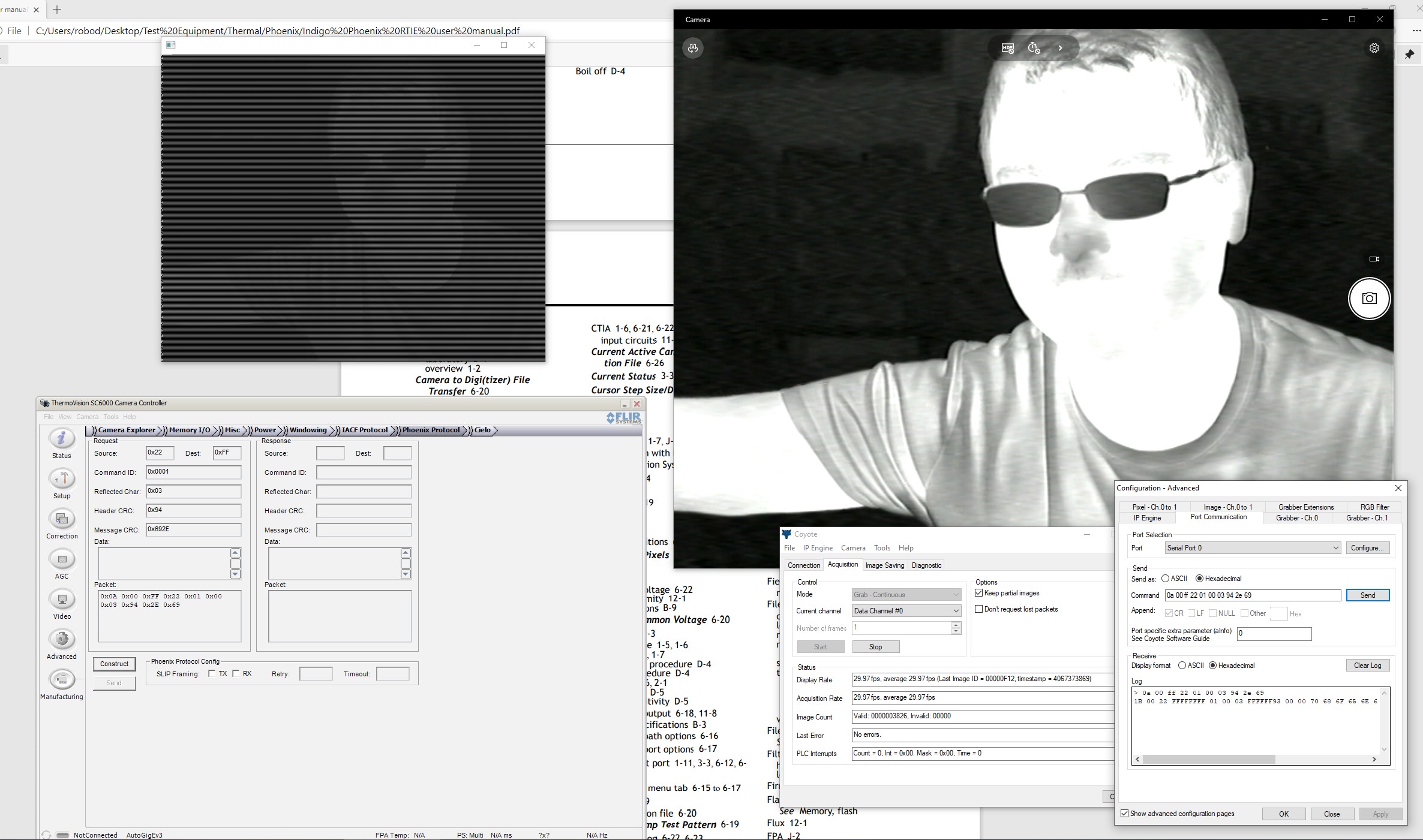On the software side:
Basically nothing current or previous generation likes to interface with the Phoenix, so a patchwork solution is the best that I've got so far. I am currently using FSWin from the Themovision SDK 2.6 to communicate with the camera and Pleora's Coyote application for digital video capture.
I was told by FLIR that ThermaCAM Researcher 2.10 will interface with it.... but Phoenix isn't even in the camera selection menu. In Researcher 2.9, it's in the menu, but it always says "device not present" even when connecting through an already verified channel - and there's no output from the PT1000's serial port, so I think Researcher 2.9 is probably looking specifically for the DTS module and just doesn't work with the PT1000. The LabView SDK 3.3 claims to be able to interface with it in documentation, but in the sample VIs there is no listing for the camera, and I haven't been able to get them to fully run even by manually adding the Phoenix to entry 10 in the VIs - I am fairly new to LabView so it may be possible, but I haven't manged yet.
Most other FLIR software doesn't seem to be able to talk to it - ResearchIR may be able to, but this project has been going on long enough that my 30 day trial expired before I actually made the connection properly, so I'll have to find another machine to try it on at some point.
The camera was originally designed for Talon, IRView, and a GUI made by Indigo (probably for Windows 98/2000), then when FLIR bought Indigo, RTools seemed to be the control software of choice, but I haven't been able to find any of those to try.
The SC6000 GUI actually sheds some light on the problem - an SC6000 seems to basically be a Phoenix and a DTS in the same chassis - but if you enter the maintenance mode (described in another thread, but Ctrl-Shift-M then enter password "indigo"), you get access to a menu that will format Phoenix commands. It can't send them - sending them crashes the program even under Windows XP - and you don't know what the command is, just the hex value, but you can format a hex command with proper CRC in the SC6000 GUI and then send it via a terminal to the RTIE and get what appears to be an appropriate response - the 0x0001 command returns "phoenix camera" in ascii, the 0x0020 command appears to reset the video feed (a bit of garbage/interlacing issue then a second later it's fine again), and somewhere in the 60 or so commands I tried sending (with no data, just the command itself), I managed to fix the gain on the analog output and I think tinker with an NUC setting. It would be a bear to try and reverse engineer the commands from the hex, but it's at least possible.
How did I eventually do it? Well almost all the software in question is licensed... but if you download the Thermovision SDK and open the ISO, you can just open the .cab file there and copy the contents into a folder - giving you access to fswin, fsviewer, and the documentation (you have to append the .pdf to it) and the source code to each. It's missing some file structure, but it does work. Then you'll need FLIR's Pleora SDK redistributable components to get the iPort drivers and Coyote, which is quite useful for connecting with the camera and doing basic IO functionality. I haven't been able to get fswin or fsviewer to show digital video - the program crashes without explanation if you set the video source to gigabit ethernet as well - but if you set the video source to File, the camera can still be controlled to a degree through the UART on the PT1000, and you can get the digital video through Coyote.

My first full connection to the camera over the PT1000, this is with Interlacing enabled but without enabling line sync yet, if I remember right.
In the thermovision SDK there should be all the camera controls needed to do exposure and gain adjustments as well as shutter calibration and whatnot, but these functions aren't fully listed in the sample applications they provide, so it would be a build-your-own GUI from the source code sort of effort (which it very well may come to).
I hope there is more to come on the software front, I'd really love a GUI application to control exposure, framerate, windowing, and shutter calibration that can also show video and adjust the palate/gain settings on the video - 14 bit image data only counts if you can view it in something other than grayscale on a monitor with 8 bits a channel!
Finally, a thank you specifically to Fraser for locating some documentation and starting off the troubleshooting, Peter who went back and fourth a bit with email in trying to get these things running, and ebay user rokkorcat for some extra info on the PT1000 and interfacing with other Indigo cameras. There's so little information available and so little of it FLIR seems to know about, it would have taken many times the effort without the assistance.